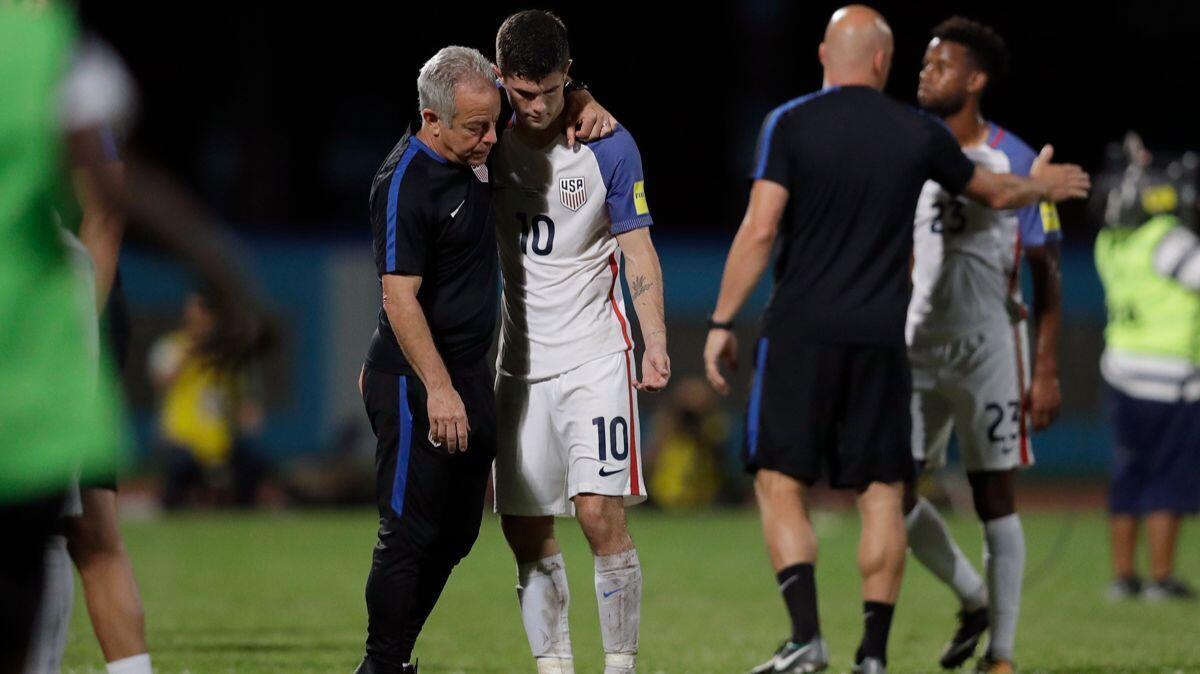What’s next for U.S. soccer after not qualifying for World Cup?

The analysis and second-guessing began before the U.S. national team had even left the tiny stadium in central Trinidad that forever will be linked to one of the most epic failures in American soccer history.
The U.S. entered the final day of World Cup qualifying Tuesday in control of its destiny, needing only a tie against Trinidad and Tobago to advance to an eighth consecutive World Cup. Instead, it was outplayed, outhustled and outclassed by the 99th-ranked team in the world.
And when Panama and Honduras won their qualifiers moments later, the Americans’ fate was sealed and a generation of men’s soccer progress in the U.S. was stalled: The national team was out of the World Cup for the first time since 1986.
“If you don’t look at yourself after this, I think you’re pretty [messed] up in the head,” forward Jozy Altidore said.
“What was supposed to be a celebration is now. … I don’t even know what to say. Terrible,” said defender Omar Gonzalez, whose own goal played a big part in the 2-1 loss.
Although the 10-game qualifying campaign seemed snakebit for the U.S. from the beginning, Tuesday’s game was a disaster. Coach Bruce Arena, who had rotated the lineup between games throughout qualifying, used the same 11 starters as five days earlier in a U.S. victory over Panama.
And the team came out dead-legged and flat, falling behind 2-0 before it even had a shot on goal.
Trinidad and Tobago’s game plan was better, too, clogging the midfield and denying the U.S. the space it had exploited so well against Panama.
“It was a night where everything went wrong,” Michael Bradley said.
“You can go around in circles a million times, but the reality is that it was all there for us and we have nobody to blame but ourselves.”
And the ripples, and blame, for Tuesday’s loss extend far beyond the playing field.
Not playing in the World Cup could cost U.S. Soccer and its sponsors more than $250 million in lost endorsements and prize money. Fox Sports, which paid more than $400 million for the English-language broadcast rights to the 2018 and 2022 World Cup, will also take a financial bath.
Three years ago in Brazil, a group-play game between the U.S. and Portugal drew a record 18.2 million viewers to ESPN, about 1 million more than watched the tournament final on sister station ABC. But without a U.S. team to galvanize an audience, Fox Sports will have trouble matching those numbers.
The absence of a monthlong, nationally televised advertisement for soccer next summer could also halt the growth of a sport that claims 11.9 million players in the U.S., trailing only basketball and baseball among team sports.
“It’s a blow against the team, for us, for the country, for the sport in the country,” Altidore said. “We have to respond to that.”
It’s too early to say what that response may look like, but two men likely to receive much of the focus for the failure are Arena and Sunil Gulati, the three-term president of the United States Soccer Federation.
Arena, a Hall of Fame coach who led the Galaxy to three MLS titles and won more games for the U.S. than any other coach, was brought back in November to rescue a team that had lost its first two qualifiers under Jurgen Klinsmann.
And Arena righted the ship, going 10-2-6 in his 10 months. But only three of those victories, and both losses, came in World Cup qualifiers.
“It’s a blemish for us. We should not be staying home from this World Cup,” Arena said. “We played poorly.”
It’s likely Arena, 66, will be replaced early next year as the U.S. begins retooling to make a run at the 2022 World Cup. But he says there’s no need to overhaul the structure of the U.S. Soccer program.
“There’s nothing wrong with what we’re doing,” he said. “To make any kind of crazy changes would be foolish. We’re building a good professional league. We have players playing abroad.
“There’s no excuses for us to not qualify for the World Cup.”
Except they didn’t.
Gulati’s situation is a bit more complicated. The Columbia economics professor is expected to stand for reelection in February to what would be a fourth term as federation president. And the failure to reach the World Cup, plus the U.S. team’s failure to qualify for the last two Olympic tournaments, is likely to be a big issue in the campaign.
However, Gulati, 58, is also a member of FIFA’s executive council and is leading a delicate three-nation effort that would have the U.S., Mexico and Canada play host to the 2026 World Cup. A vote on that bid isn’t expected until June, four months after U.S. Soccer’s presidential election.
“We’ll start looking at all that,” Gulati said of U.S. Soccer’s path forward. “In some sense, 2022 starts [now] for us.”
Not surprisingly, Gulati joined Arena in cautioning against sweeping changes, noting that if a second-half shot by Clint Dempsey had slipped into the net instead of striking the goalpost, the conversation would be quite different.
“You don’t make wholesale changes based on the ball being two inches too wide or two inches too thin,” he said. “We will look at everything, obviously. All of our programs, both the national team and all of the development stuff.
“But we’ve got a lot of pieces in place that we think are very good.”
They are in
Thirty-two countries will play in the World Cup in Russia. These 23 teams have qualified:
Argentina, Belgium, Brazil, Colombia, Costa Rica, Egypt, England, France, Germany, Iceland, Iran, Japan, Mexico, Nigeria, Panama, Poland, Portugal, Russia, Saudi Arabia, Serbia, South Korea, Spain and Uruguay.
Follow Kevin Baxter on Twitter @kbaxter11







